I'll tell y'all a little about the traditional foods that people eat around here. Around here is northern Ghana, specifically the Upper East Region, because that's what I know and that's where I am. Other parts of the country do it a little differently, and the southern half of the country is significantly different culturally and culinarily, but you'll get the idea.
Ingredients are fairly limited around here, so people make due with what they have. A basic meal is usually made up of a dense carbohydrate and a vegetable based stew or soup. Basic ingredients available: tomatoes, onions, garlic, ginger, oil, groundnuts (that's peanuts), okra, peppe (little, very hot peppers). Another ingredient that is in most things is maggi cubes (commercial bullion seasoning) but I don't use that much.
The most typically northern food is called TZ (pronounced Tee Zed), which stands for "Toa Zhafi", the name in Hausa (widely spoken west african langauge). In Frafra, the food is called "sagebo" (pronounced sah-gay-boh. TZ is made from flour and water and can be made of maize, millet, or wheat flour. I like the maize TZ the best, and that's the kind that Robert makes most often, and is teaching me to make. Water is mixed with a small amount of flour and heated to boiling. Some of the flour water is removed and then lots of flour is added to the pot. Stirring continuously, the watery mixture is added a little at a time to make a thick cream-of-wheat consistancy. You have to stir constantly or it will burn, so it is cooked on the ground. Specially made metal hooks are put through the handles of the thick cast aluminium pot and the ends of the hooks are held with the feet, to keep the pot steady. Both hands are used to stir with a big wooden spoon/paddle. When the TZ is ready and the right thickness, it is poured into bowls and plates and allowed to cool. As it cools, it gets thicker and thicker until it can be eaten by breaking pieces off the main lump. It reminds me of semi solid cream-of-wheat cereal. It can also be made with slightly fermented flour water, or boiled seeds and tree bark can be added for a certain flavor that I don't really like.
When you eat it, you use your hands, of course, and only your right hand. I break off pieces of TZ and dip/scoop up some soup to go with it. TZ is best with okra stew or groundnut with Aleefu stew. Both of these are tomatoe based, with onion, peppe, and oil, okra strew has boiled cut up okra, which becomes very slimy and stringy. It's kind of like snot, and takes some getting used to. Okra stew is mostly only eated with TZ. Aleefu is a leaf (looks similar to a maple leaf) that is boiled and is similar to spinach when cooked. Canned fish is sometimes added to this one. Groundnut paste (peanut butter? it's not butter!) is added to make the soup smooth and creamy. Yum!
Rice balls are made by stirring rice cooked with a little extra water. It becomes a thick paste that is then made into balls (tennis to soft sized) and allowed to cool. It is eaten the same way as TZ with groundnut soup.
Banku is fermented corn dough formed into balls and eaten with the hands along with light soup or sometimes okra stew. Kenke is also fermented corn dough that is wrapped in corn husks (Gaa kenke) or plantain leaves (Fanti kenke) and boiled for some time. The names refer to the tribes that originally made them, but they are both common here and neither tribe is from the north. Kenke is eaten with a bit of tomanto stew or some peppe sauce (like salsa). Fufu is made by pounding boiled cassava, plantain, yam, or a combination of two until it becomes a dense sticky doughy lump. Fufu isn't northern, but people make it here sometimes. It's usually eaten with light soup, which is (as the name implies) a light tomato-based soup with plenty of oil and peppe.
Along with these foods, rice is very common: Plain rice with tomanto-vegetable stew, fried rice with a few veggies in it, and jolloff rice (rice cooked in a spicy tomato-fish sauce). Chicken, fish, or meat (usually goat) is normally offered as well. If you go to chop bar (food stand on the street) they may give you some "salad" with your rice which consists of shredded cabbage and lettuce, carrots, green peppers and some mayonaise-ish salad cream.
At home, when I cook "ghanaian" or when Robert cooks, we have rice and stew, TZ, and rice balls most of the time. When I cook for myself, I tend to make some variation on macaroni and cheese.
I'm eating well and enjoying the food here. An interesting note on "table manners": very different expectations here. When you eat with your hands, you naturally tend to hunch over your bowl. In Ghana, it is seen as rude to talk during a meal and very rude to reach into a communal bowl with your left hand. Also, you always bring food to your mouth with your right hand.
Try this next time you are eating with tolerant people. A rice dish is a good one to practice with: Hunch over your plate and put your left hand in your lap. Wash your right hand and put your right elbow on the table so that you can reach your food with your hand. Mix your food around and play with it a little (eating has now become a tactile experience!). Pick up some rice in your hand and hold it on your last three fingers. If you want, you can squeeze it to keep it together. Cock your wrist so that your last three fingers point towards your mouth and act like a spoon. Put the food in your mouth, push it off your fingers with your thumb. Lick your fingers often. You can eat anything this way, but if it is a very thin soup, just pick up the bowl and drink it after you've finished your TZ.
Food is fun, and I look forward to cooking and eating Ghanaian food with you, my loved ones, when next we meet. Take care of yourselves and eat well.
Love,
-Toby
Subscribe to:
Post Comments (Atom)






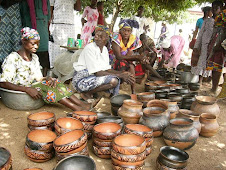
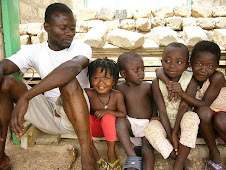

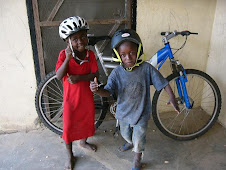



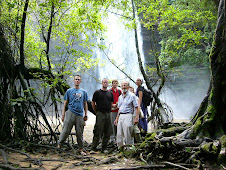

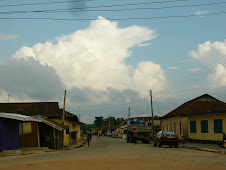



No comments:
Post a Comment